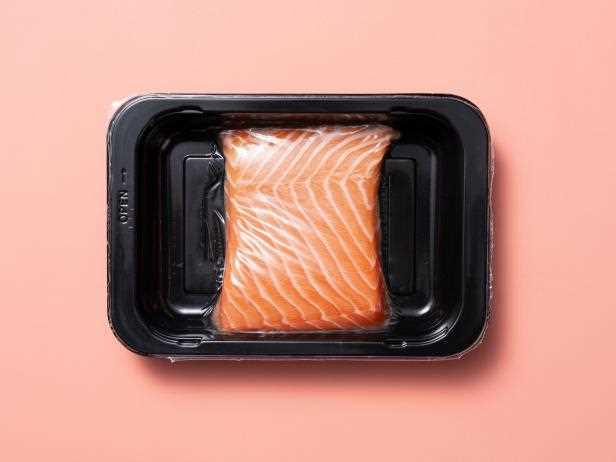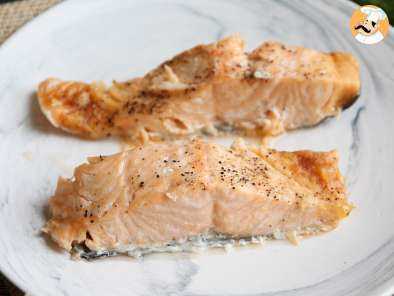







Salmon is a popular fish that is known for its rich flavor and high nutritional value. However, many people are unsure about the best way to cook salmon, especially when it comes to using a microwave. While cooking salmon in the microwave may not be the most traditional method, it can still be a convenient and quick way to prepare this delicious fish.
One of the main concerns when cooking salmon in the microwave is whether it will turn out dry and overcooked. However, with the right technique and timing, you can achieve perfectly cooked salmon that is moist and tender. It is important to follow some guidelines to ensure the best results when cooking salmon in the microwave.
Firstly, it is recommended to use a microwave-safe dish or a microwave steamer to cook salmon. This will help to retain the moisture and flavors of the fish. Additionally, covering the fish with a microwave-safe lid or wrap can help to trap the steam and prevent the fish from drying out.
Overall, while cooking salmon in the microwave may not be the most traditional method, it can still be a convenient and efficient way to prepare this popular fish. By following some guidelines and using the right technique, you can achieve delicious and perfectly cooked salmon that is moist and flavorful.
Is It Possible

Cooking salmon in the microwave is possible, but it may not produce the same results as other cooking methods. The microwave is known for its quick and convenient cooking capabilities, but it can also result in less even cooking and changes in texture.
When cooking salmon in the microwave, it is important to follow certain steps to ensure the best possible outcome. First, place the salmon in a microwave-safe dish and season it as desired. Next, cover the dish with microwave-safe plastic wrap or a microwave-safe lid to trap the steam and moisture. This will help to prevent the salmon from drying out.
Microwave Settings
When microwaving salmon, it is recommended to use the defrost or low power setting to allow for more even cooking. Cooking the salmon on high power may result in overcooking or uneven cooking. Start by microwaving the salmon for a short amount of time, usually around 1-2 minutes, and then check the internal temperature with a food thermometer. The salmon should reach an internal temperature of 145°F (63°C) for safe consumption.
Considerations
It is important to note that microwaving salmon may not achieve the same crispy texture that can be achieved with other cooking methods such as baking or pan-searing. Microwaving the salmon may result in a softer texture, which may not be desirable for some individuals.
Additionally, microwaving may not be the best option for large cuts of salmon as they may not cook as evenly. It may be best to use smaller fillets or portions when cooking salmon in the microwave.
In conclusion, while it is possible to cook salmon in the microwave, it may not be the preferred method for achieving the desired texture and results. It is important to follow proper cooking techniques and to monitor the cooking process to prevent overcooking and to ensure food safety.
Benefits of Microwave Cooking
Microwave cooking offers several benefits compared to conventional cooking methods. Here are some of the advantages of using a microwave to cook your food:
- Speed: One of the main advantages of microwave cooking is its speed. Microwaves can cook food much quicker than traditional ovens or stovetops. This is due to the way microwaves generate heat, by using electromagnetic waves to directly heat the food. This means you can prepare your meals in a fraction of the time.
- Convenience: Microwaves are incredibly easy to use, making them a convenient option for busy individuals or those who are short on time. With just a few buttons and timing adjustments, you can quickly and effortlessly cook your food. Additionally, microwaves often come with preset cooking options for common foods, taking the guesswork out of cooking times.
- Energy Efficiency: Microwaves are more energy-efficient than conventional ovens, as they heat the food directly, rather than heating the surrounding air or cookware. This helps to reduce energy consumption and ultimately lower your utility bills.
- Preserves Nutrients: The short cooking times in a microwave help to preserve more of the nutrients in the food compared to other cooking methods. The quick cooking process ensures that fewer vitamins and minerals are lost in the cooking process.
- No Oil Required: Many dishes can be cooked in a microwave without the need for added oil or fat. This can be a healthier alternative to frying or sautéing, as it reduces the amount of added calories and unhealthy fats in your meals.
Overall, microwave cooking offers numerous benefits, from saving time to preserving nutrients in your food. It is a convenient and efficient cooking method that can be a valuable addition to any kitchen.
Alternative Cooking Methods
While cooking salmon in the microwave is a popular option, there are several alternative cooking methods that can result in delicious, flavorful fish.
| Method | Description |
|---|---|
| Baking | Baking salmon in the oven is a simple and popular method. Preheat the oven to the desired temperature, place the salmon on a baking sheet, and cook for the recommended time. |
| Grilling | Grilling salmon adds a smoky flavor and crispy texture. Preheat the grill to medium-high heat, place the salmon on a well-oiled grill grate, and cook for a few minutes on each side until cooked through. |
| Pan-Frying | Pan-frying salmon results in a crispy exterior and moist interior. Heat a frying pan over medium-high heat, add oil or butter, and cook the salmon for a few minutes on each side until golden brown. |
| Poaching | Poaching salmon in liquid, such as water or broth, is a gentle cooking method that keeps the fish moist and tender. Simmer the liquid in a pan, add the salmon, and cook until it reaches the desired doneness. |
| Steaming | Steaming salmon preserves its delicate texture and flavors. Place a steamer basket in a pot with a small amount of water, bring it to a boil, add the salmon, and steam for the recommended time. |
These alternative cooking methods offer a variety of textures and flavors for preparing salmon, allowing you to choose the method that suits your preferences and cooking equipment.
How to Cook Salmon in the Microwave
Salmon is a healthy and delicious fish that can be cooked in various ways, including in the microwave. Cooking salmon in the microwave is quick and easy, making it a convenient option for busy individuals. Here’s a simple guide on how to cook salmon in the microwave:
Ingredients:
- 1 salmon fillet
- 1 tablespoon of butter
- 1 lemon, sliced
- Salt and pepper to taste
Instructions:
- Place the salmon fillet on a microwave-safe dish.
- Season the salmon with salt and pepper to taste.
- Place the butter on top of the salmon.
- Arrange the lemon slices on top of the salmon.
- Cover the dish with microwave-safe plastic wrap, leaving a small vent for steam to escape.
- Microwave the salmon on high power for 3-4 minutes per 100 grams of salmon. For example, if your salmon fillet weighs 200 grams, microwave it for 6-8 minutes.
- Check the doneness of the salmon by gently poking it with a fork. The flesh should be flaky and opaque.
- If the salmon is not done, continue microwaving it in 1-minute increments until it reaches your desired doneness.
- Once done, carefully remove the dish from the microwave using oven mitts, as it will be hot.
- Let the salmon rest for a few minutes before serving to allow the juices to redistribute.
Note: Cooking times may vary depending on the wattage of your microwave and the thickness of the salmon fillet. It’s important to always check the doneness of the salmon to avoid overcooking.
Now that you know how to cook salmon in the microwave, you can enjoy a delicious and healthy meal in no time. Serve the salmon with your favorite side dishes and enjoy!
Tips and Tricks

When cooking salmon in the microwave, it’s important to keep a few tips and tricks in mind to ensure the best results. Here are some handy pointers to help you master the art of microwave salmon:
Choose the right salmon
When cooking salmon in the microwave, it’s best to opt for thicker cuts or fillets to prevent the fish from becoming overcooked. Thicker cuts tend to retain moisture better, resulting in a juicy and flavorful dish.
Season it well
Before microwaving, make sure to season your salmon with desired flavors. You can use a simple combination of salt, pepper, and lemon juice, or experiment with various herbs and spices to enhance the taste. Remember that the microwave can intensify flavors, so a little goes a long way.
Use a microwave-safe dish
When cooking salmon in the microwave, always use a microwave-safe dish to prevent any harmful chemicals from leaching into the food. Glass or ceramic dishes are usually ideal for this purpose.
| Salmon thickness | Microwave cooking time |
|---|---|
| 1/2-inch | 3-4 minutes |
| 1-inch | 5-6 minutes |
| 1 1/2-inch | 7-8 minutes |
These cooking times are approximate and may vary depending on the power of your microwave. It’s always a good idea to check the salmon for doneness using a fork – it should flake easily when cooked.
By following these tips and tricks, you’ll be able to create a delicious and convenient salmon dish right in your microwave. Enjoy!
Questions and answers
Can I cook salmon in the microwave?
Yes, you can cook salmon in the microwave. It is a quick and convenient way to prepare salmon.
Is it safe to cook salmon in the microwave?
Yes, it is safe to cook salmon in the microwave as long as it is cooked thoroughly. Make sure to follow proper cooking times and temperatures.
How do I cook salmon in the microwave?
To cook salmon in the microwave, place the salmon fillet in a microwave-safe dish and season it with your desired spices and herbs. Cover it with a microwave-safe lid or plastic wrap and cook on medium power for about 4-6 minutes per fillet.
Is microwaving salmon as healthy as other cooking methods?
Microwaving salmon can be a healthy cooking method because it requires little to no added fats. However, some nutrients may be lost during the cooking process, so it is always best to consume a variety of cooking methods for a well-rounded diet.
Can I microwave frozen salmon?
Yes, you can microwave frozen salmon. Thaw it first in the microwave using the defrost setting, then cook it following the same instructions for fresh salmon.
Can I cook salmon in the microwave?
Yes, you can cook salmon in the microwave. It is a quick and convenient way to prepare this fish.
What is the best way to cook salmon in the microwave?
The best way to cook salmon in the microwave is to place it on a microwave-safe dish, season it with herbs and spices, cover it with a microwave-safe lid or plastic wrap, and cook it on high power for a few minutes. Make sure to check for doneness before serving.







